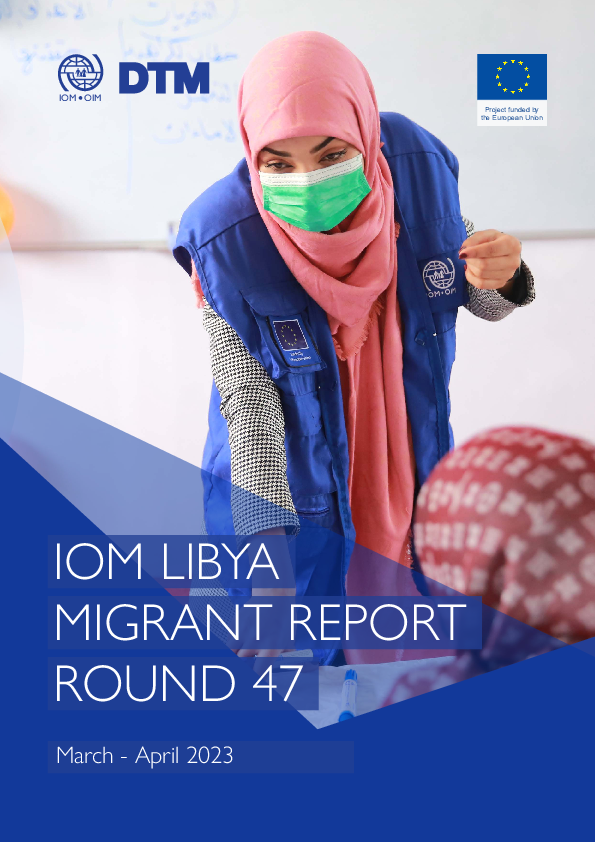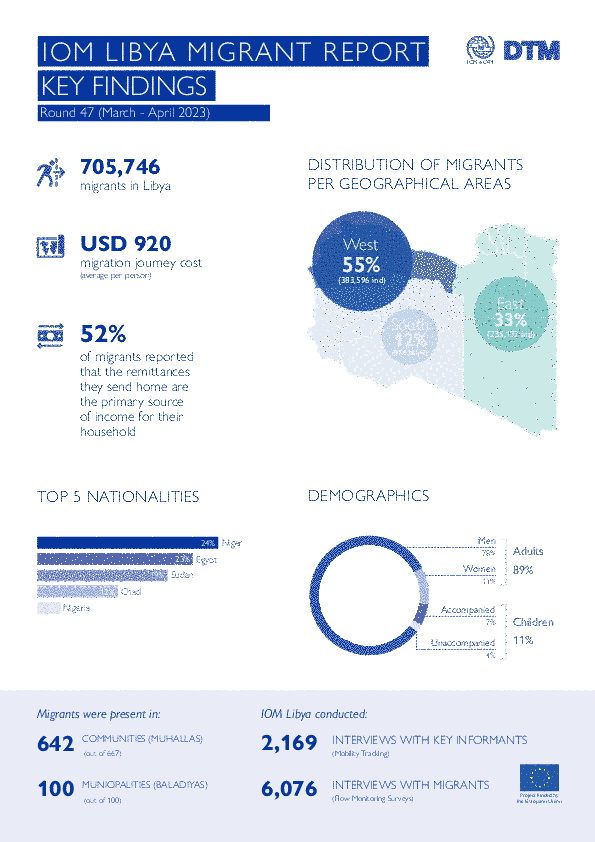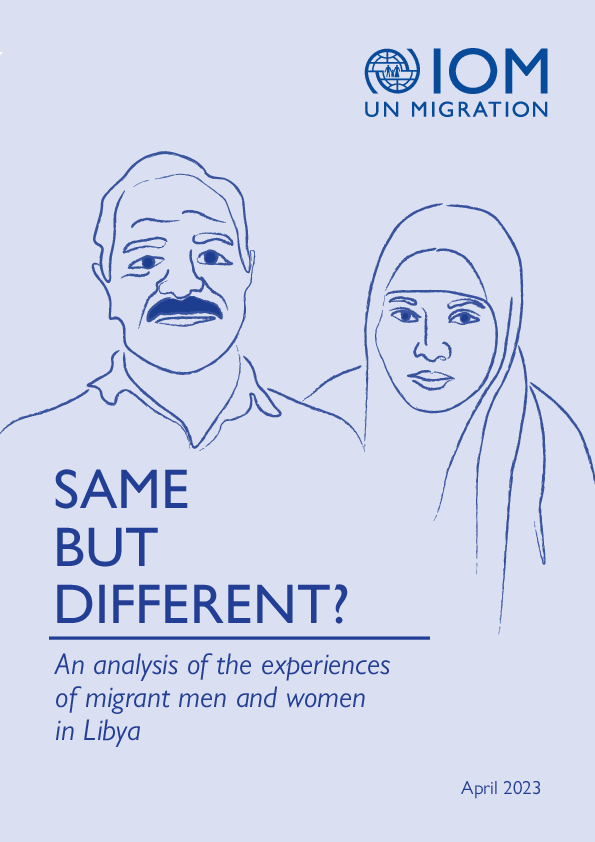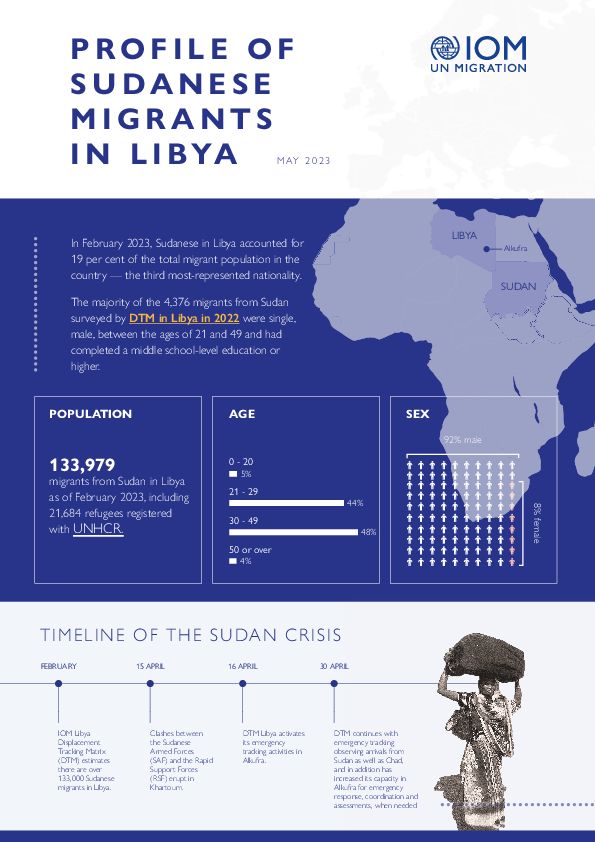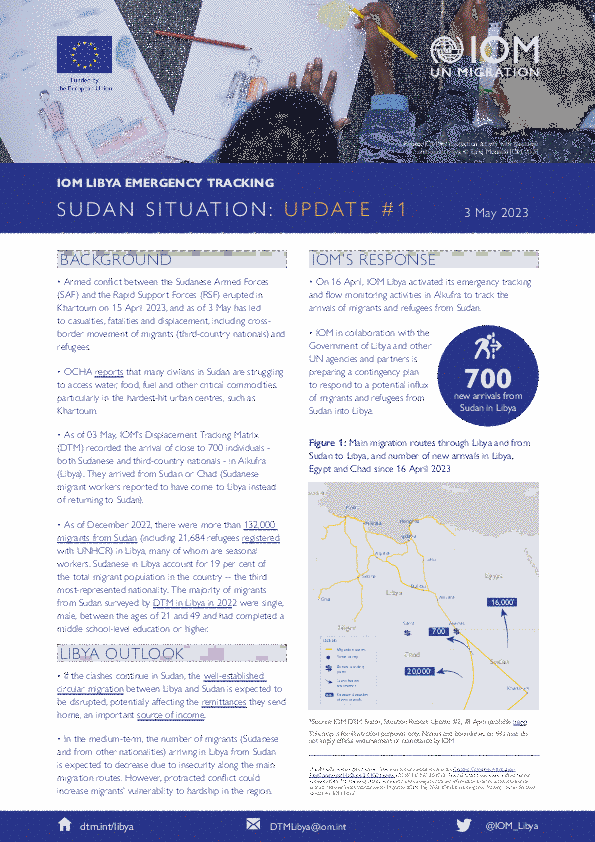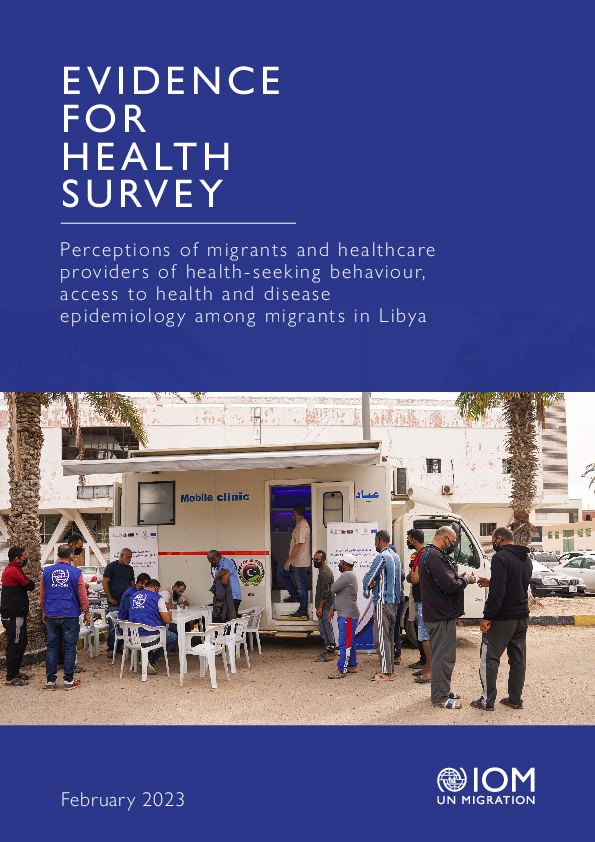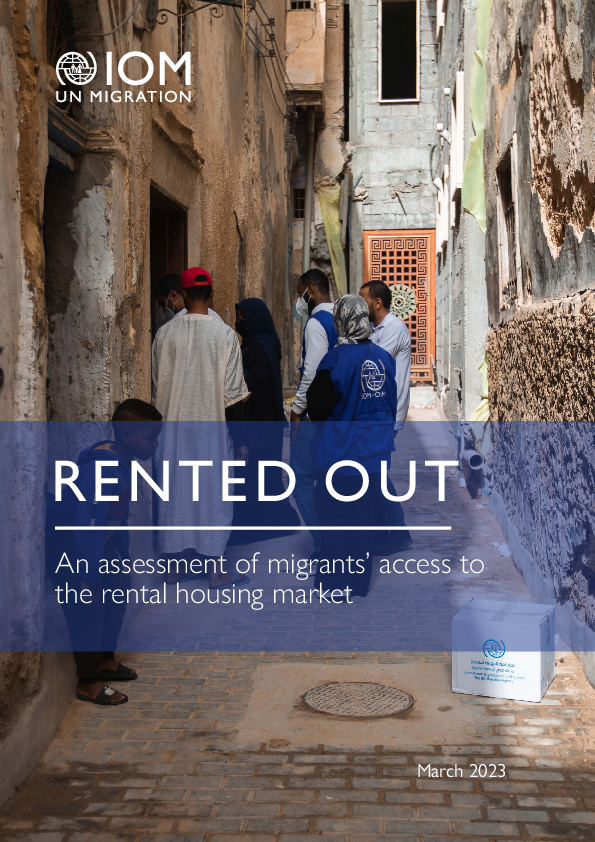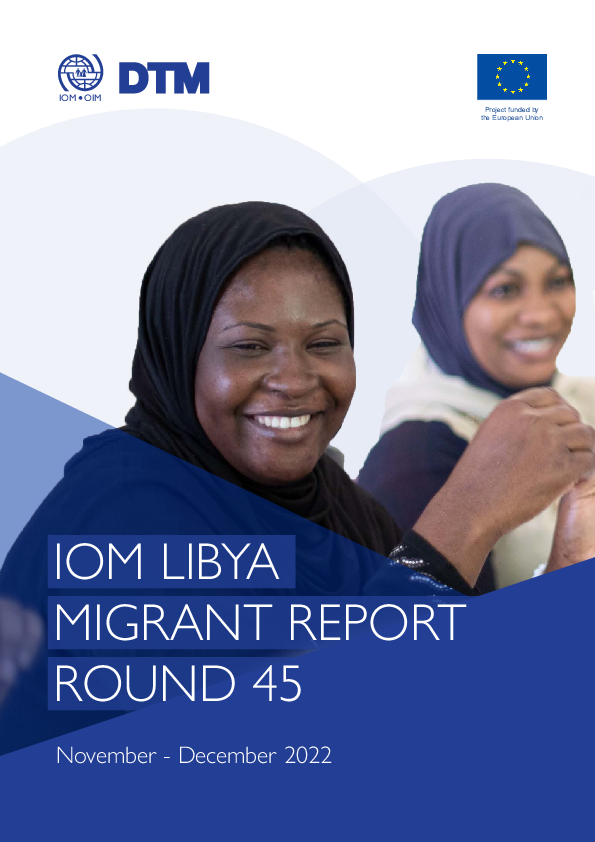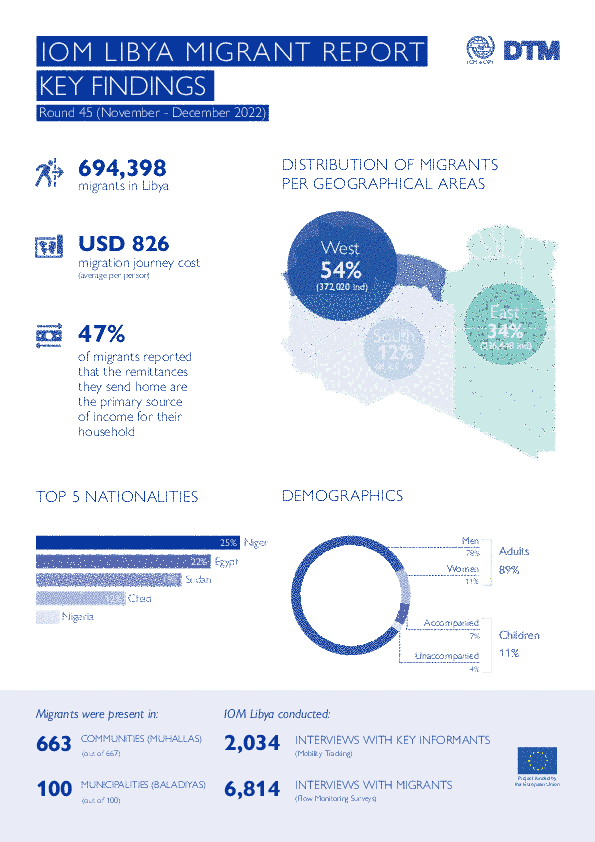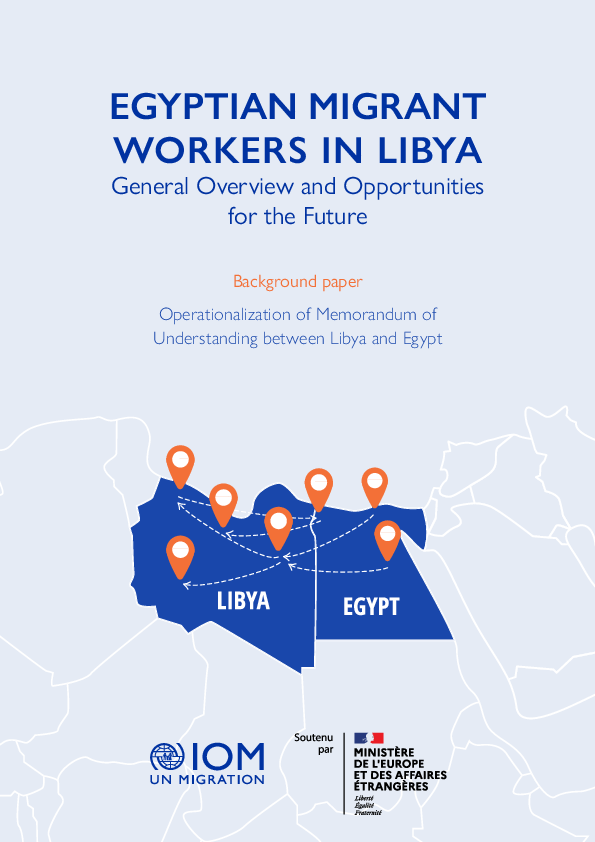-
Countries
-
Data and Analysis
-
Special Focus
-
Crisis Responses
Libya
About Libya
Libya is a geographically vast country with several regions that are difficult to access. In order to understand the full scope of humanitarian assistance that is needed throughout the country, IOM established the Displacement Tracking Matrix (DTM) programme in 2016 in order to provide a common operating picture concerning the movement of populations in Libya, allowing humanitarian actors to provide timely assistance to those in need. Following the escalation of conflict and insecurity in 2014, the security situation has remained volatile since with fluctuations in the intensity of localized clashes. Congruently, conflict has caused new displacements, often in areas ill-equipped to accommodate large population movements while also negatively impacting the large migrant population residing and transiting through Libya. More recently, the capital Tripoli was heavily affected by displacement waves in September 2018 and April 2019.
DTM’s mobility tracking and flow monitoring activities identified many migrants in-country to be in need of various forms of assistance. Libya’s geographic location, resources and work opportunities has made it both a country of destination and transit for migrants for many years. Despite the deterioration of the security situation since 2011 migrants continue coming to and transiting through Libya, the majority from Sub-Saharan and North African countries.
In this complex operating environment, DTM Libya has been providing a common operating picture concerning the movement of populations in Libya since 2016, allowing humanitarian actors to provide timely assistance to those in need. Through its mobility tracking, flow monitoring and needs assessment activities, DTM Libya has established itself as data hub for quantitative data on migratory flows to and within Libya, migrant presence in Libya disaggregated by nationality and area, as well as humanitarian needs of migrants, internally displaced population and returnees. All activities are implemented through periodical bi-monthly data collection cycles, allowing trend analysis over time to provide evidence-base for both policy-level discussions and to guide humanitarian action.
In order to facilitate humanitarian interventions, DTM works closely with IOM’s other programmes through referring identified populations in need of assistance at flow monitoring points to IOM’s Direct Assistance, Health, Voluntary Humanitarian Return (VHR), Protection and Migrant Rapid Response Mechanism (MRRM) programmes. Furthermore, DTM Libya supports other humanitarian partners through providing emergency tracking updates in case of sudden population movements as well as facilitating humanitarian assessments for the Rapid Response Mechanism (RRM) jointly implemented by IOM, UNICEF, WFP and UNFPA.
For more information on IOM's activities in Libya, please visit the IOM Libya country office website.
Contact
DTM Libya
DTMLibya@iom.int
Current Donors
- EUTF
Libya — Detention Centre Profile Generator (August 2023)
Detention Centre Profiling is a component of IOM Libya’s Displacement Matrix programme. It is a data oriented tool that routinely provides specific sex and age demographic data and key sectorial information on individuals held in Libya’s detention centres on the date of assessment.
Libya — Displacement and Solutions Report Key Findings (August 2023)
This infographic presents the key findings from the Displacement and Solutions Report. The data used in the report is from the mobility tracking component of the Displacement Tracking Matrix (DTM) programme in Libya.
Libya — Displacement and Solutions Report (August 2023)
This publication presents DTM Libya’s Displacement and Solutions Package, which presents the analysis of displacement situation in Libya using Data for Solutions to Internal Displacement (DSID) framework.
Libya — Migrant Report 47 (March - April 2023)
This publication presents DTM Libya Round 47 Migrant Information Package, covering the reporting period March – April 2023.
Aug 08 2023
Libya — Migrant Report 47 (March - April 2023)
Migrant Report Key Findings 47 (March - April 2023)
This infographic presents the key findings of Round 47 of the mobility tracking component of the Displacement Tracking Matrix (DTM) programme in Libya.
Libya — Detention Centre Profile Generator (July 2023)
Detention Centre Profiling is a component of IOM Libya’s Displacement Matrix programme. It is a data oriented tool that routinely provides specific sex and age demographic data and key sectorial information on individuals held in Libya’s detention centres on the date of assessment.
Same but different: An analysis of the experiences of migrant men and women in Libya (April 2023)
This study is part of IOM Libya’s efforts to gain a better understanding of how specific vulnerabilities influence the experiences of migrant women and men in the country. This assessment compares the issues that migrant men and women experience in Libya and are associated with four key area
Libya — Detention Centre Profile Generator (June 2023)
Detention Centre Profiling is a component of IOM Libya’s Displacement Matrix programme. It is a data oriented tool that routinely provides specific sex and age demographic data and key sectorial information on individuals held in Libya’s detention centres on the date of assessment.
Libya — Detention Centre Profile Generator (May 2023)
Detention Centre Profiling is a component of IOM Libya’s Displacement Matrix programme. It is a data oriented tool that routinely provides specific sex and age demographic data and key sectorial information on individuals held in Libya’s detention centres on the date of assessment.
Migrant Report Key Findings 46 (January - February 2023)
This infographic presents the key findings of Round 46 of the mobility tracking component of the Displacement Tracking Matrix (DTM) programme in Libya.
Libya — Migrant Report 46 (January - February 2023)
IOM Libya’s Displacement Tracking Matrix (DTM) programme identified a total of 706,062 migrants from over 44 nationalities in the 100 Libyan municipalities during round 46 of data collection (January - February 2023).
Libya — Profile of Sudanese Migrants in Libya (May 2023)
This infographic provides valuable insights into the situation and vulnerabilities of Sudanese migrants in Libya. The information pertaining to migrants’ situation and vulnerabilities is based on quantitative individual interviews conducted by DTM Libya with 888 migrants in January and Febru
IOM LIBYA EMERGENCY TRACKING - SUDAN SITUATION: UPDATE #1 (3 May 2023)
This report provides an overview of related arrivals to Libya following the onset of armed clashes in Sudan in mid-April 2023. This brief is based on information gathered through IOM Libya emergency tracking and flow monitoring activities in Al Kufra between 15 April and 2 May 2023.
Evidence for Health Survey: Perceptions of migrants and healthcare providers of health-seeking behaviour, access to health and disease epidemiology among migrants in Libya
This study is divided into two parts. The first section looks at the health-seeking behaviours and factors affecting access to healthcare among migrants in Libya.
Libya — Detention Centre Profile Generator (March 2023)
Detention Centre Profiling is a component of IOM Libya’s Displacement Matrix programme. It is a data oriented tool that routinely provides specific sex and age demographic data and key sectorial information on individuals held in Libya’s detention centres on the date of assessment.
Libya — Migration from Bangladesh to Italy via Libya (March 2023)
In 2022, 15,228 migrants from Bangladesh arrived in Italy via the Central Mediterranean Route (CMR) with a majority transiting through Libya. Migrants from Bangladesh constituted slightly more than 14 per cent of all arrivals in Italy — the third most-represented nationality.
Libya — Rented Out: An assessment of migrants’ access to the rental housing market
This report explores the factors that influence migrants’ access to the rental housing market with the objective to support programming efforts to help migrants successfully navigate the rental housing market on equitable grounds.
Libya — Migrant Report 45 (November - December 2022)
IOM Libya’s Displacement Tracking Matrix (DTM) programme identified a total of 694,398 migrants from over 42 nationalities in the 100 Libyan municipalities during Round 45 of data collection (November - December 2022).
Migrant Report Key Findings 45 (November - December 2022)
This infographic presents the key findings of Round 45 of the mobility tracking component of the Displacement Tracking Matrix (DTM) programme in Libya.
Libya — Detention Centre Profile Generator (February 2023)
Detention Centre Profiling is a component of IOM Libya’s Displacement Matrix programme. It is a data oriented tool that routinely provides specific sex and age demographic data and key sectorial information on individuals held in Libya’s detention centres on the date of assessment.
Libya — Nigerien Migrant Workers in Libya : General Overview and Opportunities for the Future [ARABIC]
يتمثّل الهدف من هذه الورقة في تقديم لمحة عامّة عن هجرة العمالة النّيجيريّة إلى ليبيا، مع التّركيز على الفرص المتعلّقة بتحسين إدارة هجرة اليد العاملة بين النّيجر وليبيا.
LES TRAVAILLEURS MIGRANTS NIGÉRIENS EN LIBYE: Aperçu général et opportunités pour l'avenir
Ce document d'information sur les travailleurs migrants nigériens en Libye vise à donner un aperçu de la situation et des opportunités pour cette population.
Libya — Nigerien Migrant Workers in Libya : General Overview and Opportunities for the Future
This background paper on Nigerien Migrant Workers in Libya aims to provide an overview of the situation and opportunities for this population.
Libya — Egyptian Migrant Workers in Libya: General Overview and Opportunities for the Future
This background paper on Egyptian Migrant Workers in Libya aims to provide an overview of the situation and opportunities for this population.
Pagination
Libya - IDPs And Returnees Baseline Assessment Round 29
2020-02-29
IDP and Returnees Round 29 Dataset
Libya - IDPs And Returnees Baseline Assessment Round 28
2019-12-31
IDP and Returnees Round 28 Dataset
Libya - IDPs And Returnees Baseline Assessment Round 27
2019-10-31
IDP and Returnees Round 27 Dataset
Libya - IDPs And Returnees Baseline Assessment Round 26
2019-09-12
IDP and Returnees Round 26 Dataset
Libya - IDPs And Returnees Baseline Assessment Round 25
2019-05-31
IDP and Returnees Round 25 Dataset
Libya - IDPs And Returnees Baseline Assessment Round 24
2019-02-28
IDP and Returnees Round 24 Dataset
Libya - Migrants Baseline Assessment - Round 24
2019-02-28
A baseline assessment is a sub-component of mobility tracking. It aims to collect data on IDP, migrant or returnee population presence in a defined administrative area of the country.
Libya - Migrant Baseline Assessment Round 23
2018-12-31
Round 23 Migrants Dataset for November and December 2018
Libya - Migrants Baseline Assessment Round 23
2018-12-31
A baseline assessment is a sub-component of mobility tracking. It aims to collect data on IDP, migrant or returnee population presence in a defined administrative area of the country.
Libya - IDPs and Returnees Baseline Assessment Round 23
2018-12-31
A baseline assessment is a sub-component of mobility tracking. It aims to collect data on IDP, migrant or returnee population presence in a defined administrative area of the country.
Libya - IDPs and Returnees Baseline Assessment Round 22
2018-10-31
A baseline assessment is a sub-component of mobility tracking. It aims to collect data on IDP, migrant or returnee population presence in a defined administrative area of the country.
Libya - Migrant Baseline Assessment Round 22
2018-10-31
A baseline assessment is a sub-component of mobility tracking. It aims to collect data on migrant population presence in a defined administrative area of the country.
Libya - IDPs and Returnees Baseline Assessment Round 21
2018-08-31
A baseline assessment is a sub-component of mobility tracking. It aims to collect data on IDP, migrant or returnee population presence in a defined administrative area of the country.
Libya - Migrant Baseline Assessment Round 21
2018-08-31
A baseline assessment is a sub-component of mobility tracking. It aims to collect data on migrant population presence in a defined administrative area of the country.
Libya - IDPs and Returnees Baseline Assessment Round 20
2018-06-30
A baseline assessment is a sub-component of mobility tracking. It aims to collect data on IDP, migrant or returnee population presence in a defined administrative area of the country.




